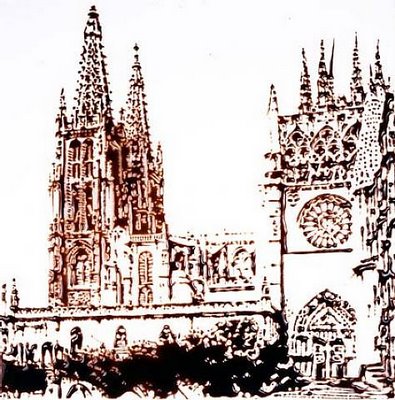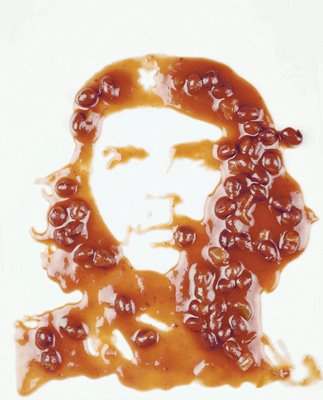
Kitty Cloud, 1993

The Rower, 1993

Catedral de Burgos (Pictures of Chocolate) 2003
“I want to make the worst possible illusion that will still fool the eye of the average person,” Muniz says. “Something so rudimentary and simple that the viewer will think, ‘I don’t believe what I am seeing, I can’t be seeing this, my mind is too sophisticated to fall for something as silly as this. Illusions as bad as mine make people aware of the fallacies of visual information and the pleasure to be derived from such fallacies. These illusions are made to reveal the architecture of our concept of truth.”

Karl Marx (Pictures of Caviar, 2004)

Frankenstein (Pictures of Caviar) 2004

Marlene Dietrich (Pictures of Diamonds) 1994
"I'm experimenting with these things as a student of media. We're at the point where in order to perceive a phenomenon, you have to change it, like particle collisions in physics. What else can you do without relying on the actual reality of things? Art is just as important as science because it completes it; one is about phenomenon while the other is about mind. One thing is totally dependent on the other; that's why I am very drawn to cognitive science. How many artists spend their entire lives making visual objects and never pick up a book to study how the eye works? They never studied the physics of light to see how light behaves. They never bought a prism, and held it against the sun, or any of these really simple things. I'm a visual artist, not a conceptualist. I make things that deal primarily with the eyes. In that regard, I'm totally old-fashioned.”

Aftermath (Sócrates) 1998

Mars, God of War, after Diego Velázquez (Pictures of Junk) 2005

Che Guevara (Pictures of Food) 1998
“Vision is a form of intelligence, even more so than hearing. Our human eyes are not nearly as good as birds' eyes or many other animals'. Instead, we have a huge visual cortex devoted just to analyzing visual stimuli. That is our true eye. I have a theory that the intellect has evolved from our inability to see everything in focus, the eye has to move to see things and by doing so it introduces the concept of narrative and the attention that is necessary for any complex idea to form.”

I wait, after Julia Margaret Cameron (Pictures of Junk) 2004
Questions:
- Why do you think Muniz presents his work as photographs of his re-creations of previous artworks, rather than, say, gluing all the pieces down and presenting the "original" work? For that matter, what level of this process is the "original" work?
- Muniz states- "Illusions as bad as mine make people aware of the fallacies of visual information and the pleasure to be derived from such fallacies. These illusions are made to reveal the architecture of our concept of truth." How do you think this idea is represented in his work?
- How would you compare and contrast Muniz' work with Thomas Demand, from Ch. 2?

4 comments:
I like these pictures the most, though I didn't the first time I looked at them. I love his comment about "These illusions are made to reveal our concept of the architecture of truth." I think that with photographs these days, especially with the airbrushing-type technology, can really create in us belief in the "fallacies of visual information." I know that has really effected me in the past. I like the titles of Muniz's photographs (especially the part in the parentheses), i.e. Pictures of Caviar, Food, Chocolate, Diamonds, Junk, etc... It's funny that I like titles so much with regard to photographs but I'm not very good at thinking of them myself. Like I've been saying all semester, I'm not an artist (it was the right side of my head that was injured in the head injury!) I think the idea in his statement is shown repeatedly through the titles of his works. They're humorous, as well as pretty good and interesting recreations of the original works. Merry Christmas everybody!!!!!!!!
Muniz states- "Illusions as bad as mine make people aware of the fallacies of visual information and the pleasure to be derived from such fallacies. These illusions are made to reveal the architecture of our concept of truth." How do you think this idea is represented in his work?
I think his work represents the fallacies of visual information in that when you look at his photographs you see a recognizable image but the photographs aren't really about the image, but more about what its made up of. It seems to me like you have to retrain your eyes when looking at these to not just glance and move on but to really analyze the whole picture.
Vik Muniz is one of my favorite artists. I think it's an odd question, asking why he takes photographs of his work instead of just presenting them, but if you have any background information about what it is he's working with, you'd know that not all mediums he chosen to work with could ever be properly presented unless photographed, due to the nature of the material alone. His junkyard images are massive, they literally take up entire warehouses and in order to visually see the image you have to be an insane distance away from them. His chocolate pieces wouldn't maintain their shine. The pieces that I love the most are his wire sculptures that, when photographed, look like line drawings. I think it's a really cool play with mediums.
As far as the concept of truth. Your mind has to think if you see it, is it really a real image? It's just junk but it makes a bigger whole. As far as not gluing the work, it can be seen that the mediums that the artist works in are not very well presevred. Demand's work is the same vien as Muniz in that they are planned and crafted, but I think that Muniz takes a more primitive approach with his mediums and Demand, who goes for realism.
Post a Comment